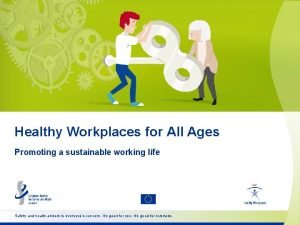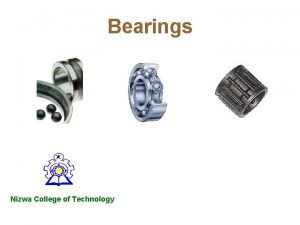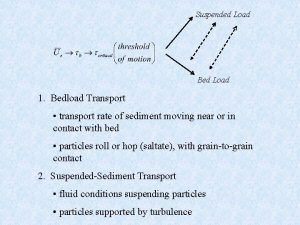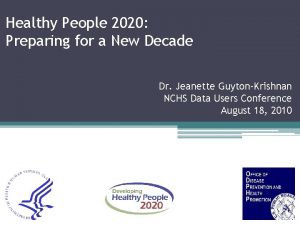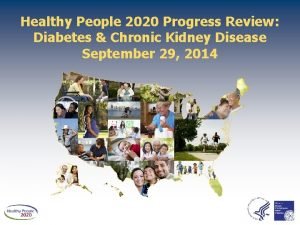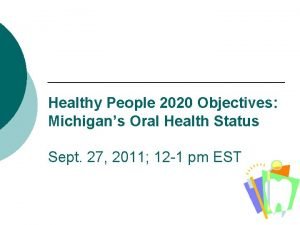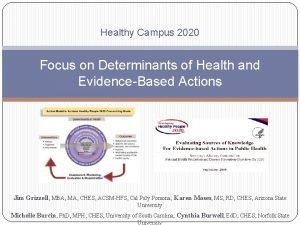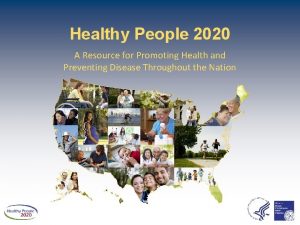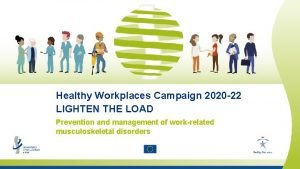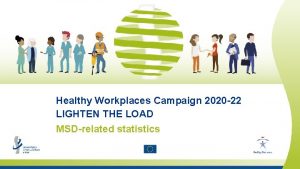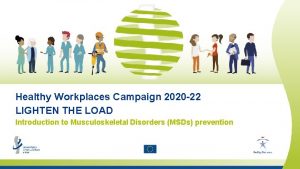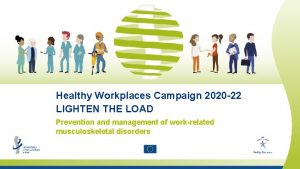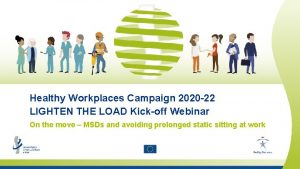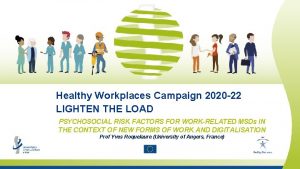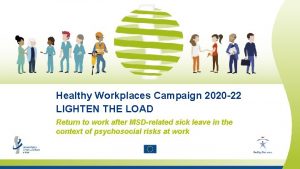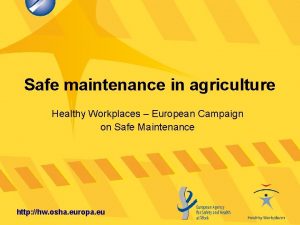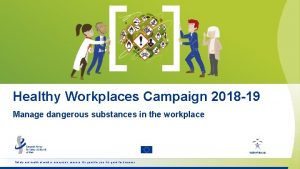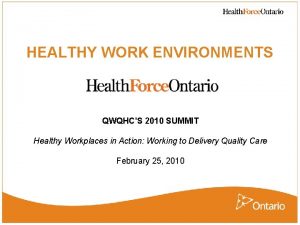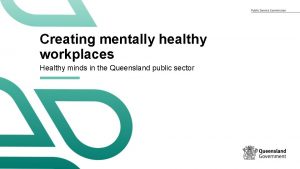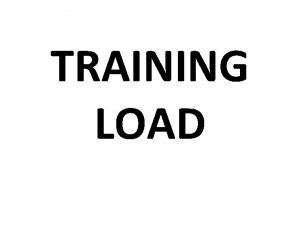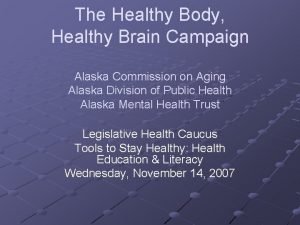Healthy Workplaces Campaign 2020 22 LIGHTEN THE LOAD





























- Slides: 29

Healthy Workplaces Campaign 2020 -22 LIGHTEN THE LOAD MSD-related statistics Safety and health at work is everyone’s concern. It’s good for you. It’s good for business.

Overview § MSDs prevalence § Impact of MSDs § MSD-related risk factors § MSDs prevention § This PPT is based on the following reports: • EU-OSHA, Work-related musculoskeletal disorders: prevalence, costs and demographics in the EU, 2019 available at: https: //osha. europa. eu/es/publications/msds-facts-and-figures-overview-prevalence-costs-anddemographics-msds-europe/view • EU-OSHA, Work-related musculoskeletal disorders: Facts and Figures — Synthesis report of 10 EU Member states reports, 2020 (AT, DE, DK, ES, FI, FR, HU, IT, NL and SE) available at: https: //osha. europa. eu/en/publications/work-related-musculoskeletal-disorders-facts-and-figures-synthesisreport-10 -eu-member/view www. healthy-workplaces. eu 2

MSDs prevalence § Around 60% of all workers with a work-related health problem, identify MSDs as their most serious issue § MSD complaints slightly decreased between 2010 and 2015 § MSD complaints vary considerably between Member States, sectors and occupations § Women report slightly more MSDs than men § MSDs prevalence is higher among older workers § MSDs prevalence decreases with educational level § MSD work-related accidents are among the most common accidents www. healthy-workplaces. eu 3

MSDs - Work-related health problem number 1 Around 60% of all workers with a work-related health problem identify MSDs as their most serious issue Others Musculoskeletal Disorders 5%: other – not specified 5%: headache, eyestrain 4%: cardiovascular disorders 4%: pulmonary disorders 2%: stomach, liver, kidney or digestive problems 1%: skin problems 1%: hearing disorders 1%: infectious diseases Stress, depression, anxiety Percentage of workers reporting a work-related health problem, by type of problem, EU-27, 2013 Source: Eurostat, Labour Force Survey ad hoc module ‘Accidents at work and other work-related health problems’ (2013) www. healthy-workplaces. eu 4

MSD complaints only slightly decreasing The proportion of workers reporting MSD complaints slightly decreased between 2010 and 2015 Muscular pains in lower limbs Muscular pains in shoulders, neck and/or upper limbs Backache One or more musculoskeletal disorders Percentage of workers reporting different musculoskeletal disorders in the past 12 months, EU-28, 2010 and 2015 Source: Panteia based on the fifth (2010) and sixth (2015) waves of the European Working Conditions Survey (EWCS) www. healthy-workplaces. eu 5

MSD complaints by Member State The proportions of workers reporting MSD complaints vary considerably between MS 2015 2010 Percentage of workers reporting that they suffered from one or more musculoskeletal disorders in the past 12 months, by Member State, 2010 and 2015 Source: Panteia based on the fifth (2010) and sixth (2015) waves of the European Working Conditions Survey (EWCS) www. healthy-workplaces. eu 6

Backache (and MSDs in general) by sector The proportions of workers reporting backache (and MSDs in general) vary considerably between sectors Water supply Agriculture, forestry and fishing Construction Human health and social work activities Manufacturing Transportation and storage Real estate activities Other service activities Arts, entertainment and recreation Accommodation and food service activities Administrative and support service activities Electricity, gas, steam and air conditioning supply Wholesale and retail trade Mining and quarrying Information and communication Public administration and defence Professional, scientific and technical activities Education Financial and insurance activities Percentage of workers reporting backache in the past 12 months, by sector (NACE rev 2), EU-28, 2015 Source: Panteia based on the sixth (2015) wave of the European Working Conditions Survey (EWCS) www. healthy-workplaces. eu 7

MSDs prevalence highest among blue-collar workers Armed forces occupations Clerical support workers Backache Craft and related trades workers Elementary occupations Managers Plant and machine operators and assemblers Muscular pains in shoulders, neck and/or upper limbs Professionals Service and sales workers Muscular pains in lower limbs Skilled agricultural, forestry and fishery workers Technicians and associate professionals One or more MSD-related health problems Percentage of workers reporting different musculoskeletal disorders in the past 12 months, by occupation (ISCO-08), EU-28, 2015 Source: Panteia based on the sixth (2015) wave of the European Working Conditions Survey (EWCS) www. healthy-workplaces. eu 8

MSDs by gender Women report slightly more MSDs than men Muscular pains in lower limbs Muscular pains in shoulders, neck and/or upper limbs Backache One or more musculoskeletal disorders Percentage of workers reporting different musculoskeletal disorders in the past 12 months, by gender, EU-28, 2015 Source: Panteia based on the sixth (2015) wave of the European Working Conditions Survey (EWCS) www. healthy-workplaces. eu 9

MSDs prevalence is higher among older workers Muscular pains in lower limbs Muscular pains in shoulders, neck and/or upper limbs Under 25 One or more musculoskeletal disorder Backache 25 -39 40 -54 55 and over Percentage of workers reporting different musculoskeletal disorders in the past 12 months, by age group, EU-28, 2015 Source: Panteia based on the sixth (2015) wave of the European Working Conditions Survey (EWCS) www. healthy-workplaces. eu 10

MSDs prevalence decreases with educational level Pre-primary education Primary education or first stage of basic education Muscular pains in lower limbs Lower secondary or second stage of basic education (Upper) secondary education Muscular pains in shoulders, neck and/or upper limbs Post-secondary non-tertiary education First stage of tertiary education Backache Second stage of tertiary education One or more MSD-related health problems Percentage of workers reporting different musculoskeletal disorders in the past 12 months, by educational level, EU-28, 2015 Source: Panteia based on the sixth (2015) wave of the European Working Conditions Survey (EWCS) www. healthy-workplaces. eu 11

MSDs-related accidents § The types of accidents related to MSDs-related are: dislocations, sprains and strains, bone fractures, and traumatic amputations (loss of body parts). § MSD work-related accidents are among the most common workrelated accidents. Distribution of fatal and non-fatal accidents at work by type of injury, EU-28, 2016 Wounds and superficial injuries Dislocations, sprains and strains Concussions and internal injuries Bone fractures Shocks Other not specified Burns, scalds and frostbites Others Source: Eurostat, European Statistics on Accidents at Work (ESAW) www. healthy-workplaces. eu 12

Impact of MSDs § MSDs have an impact on the general health of workers, for instance the proportion of workers with (very) good health is smaller for workers who suffer from MSDs § Workers with MSDs tend to be absent from work more often than others § Very high impact of MSDs in economic terms § Lack of data on the economic impact of MSDs at EU level. Some data available at Member State level: More information available at: EU-OSHA, Work-related musculoskeletal disorders: Facts and Figures — Synthesis report of 10 EU Member states reports, 2020 (AT, DE, DK, ES, FI, FR, HU, IT, NL and SE) https: //osha. europa. eu/en/publications/workrelated-musculoskeletal-disorders-facts-and-figures-synthesis-report-10 -eu-member/view www. healthy-workplaces. eu 13

Workers with MSDs and Health Proportion of workers with (very) good health is smaller for workers who suffer from MSDs (in the upper limbs, lower limbs and / or back) 2015 Very good No health problems Only other health problems Only musculoskeletal disorders Musculoskeletal disorders and other health problems Good Fair Bad Very bad 2010 Percentage of workers reporting that their health is very good, fair, bad or very bad, by different health problems in the past 12 months, EU 28, 2010 and 2015 Source: Panteia based on the fifth (2010) and sixth (2015) waves of the European Working Conditions Survey (EWCS) www. healthy-workplaces. eu 14

MSDs and comorbidities Headaches, eyestrain, overall fatigue and sleeping problems affect the lives of workers who suffer from MSDs Overall fatigue Headaches, eyestrain Waking up with feeling of exhaustion and fatigue at least several times a month Waking up repeatledly during sleep at least several times a month Difficulties falling asleep at least several times a month Anxiety Injury(ies) Note: Musculoskeletal disorders refer to backache and/or muscular pains in shoulders, neck, upper limbs and/or lower limbs (hips, legs, knees, feet etc. ) Skin problems Hearing problems Other (spontanoeous) Percentage of workers reporting the different health problems that affect their life, by presence or absence of MSDs, EU-28, 2015 Source: Panteia based on the sixth (2015) wave of the European Working Conditions Survey (EWCS) www. healthy-workplaces. eu 15

Main work-related illnesses and DALYs (Years of life lost and lived with disability). Main part is due to cancer, followed by MSD Cancer Others Circulatory Injuries MSD Distribution of years of life lost and lived with disability (DALYs) per 100, 000 workers, by main work-related illnesses, EU-28, 2017 Source: Panteia based on EU-OSHA, data visualisation (2017). Available at: https: //visualisation. osha. europa. eu/osh-costs#!/eu-analysis-illness www. healthy-workplaces. eu 16

MSDs and Absenteeism Workers with MSDs tend to be absent from work more often than others MSD-related and other health problems Never Only other health problems 1 to 4 days 5 to 9 days No health problems 10 to 19 days 20 to 49 days Total workers 50 days or more Number of days absent in the past 12 months due to a health problem: distribution of workers, for worker with MSDs and/or other health problems and without health problems, EU-28, 2015 Source: Panteia based on the sixth (2015) wave of the European Working Conditions Survey (EWCS) www. healthy-workplaces. eu 17

MSD-related risk factors § High prevalence of MSDs-risk factors in EU establishments § Significant relationship identified between self-reported MSDs and some physical risk factors § For most physical risk factors prevalence is slightly decreasing, except for working with computers, laptops, smartphones § Significant relationship identified between self-reported MSDs and organisational and psychological risk factors § Work-related stress applies to more than half of workers www. healthy-workplaces. eu 18

Most prevalent MSDs-related risk factors present in EU establishments Heat, cold or draught Lifting or moving people or heavy loads Repetitive hand or arm movements Tiring or painful positions, including sitting for long periods Heat, cold or draught Lifting or moving people or heavy loads Repetitive hand or arm movements Tiring or painful positions Prolonged sitting Percentages of employees working in establishments where different physical risk factors are in place (% establishments, EU 28, 2019 and 2014) Note: “Prolonged sitting” and “Tiring or painful positions” are new items in ESENER 2019. Previously they were covered by a single item “Tiring or painful positions, including sitting for long periods” Source: EU-OSHA based on ESENER 2014 and ESENER 2019. (ESENER – European Survey of Enterprises on New and Emerging Risks) www. healthy-workplaces. eu 19

Associations between self-reported MSDs and physical risk factors Significant relationship identified Body Area Back Lower limbs Upper limbs • • Vibrations from hand tools Working in tiring or painful positions Carrying or moving heavy loads Repetitive hand or arm movements • • Vibrations from hand tools Working in tiring or painful positions Carrying or moving heavy loads Repetitive hand or arm movements • Being exposed to low temperatures • Lifting or moving people • Working with computers, laptops, etc. • • Vibrations from hand tools Working in tiring or painful positions Carrying or moving heavy loads Repetitive hand or arm movements • • Lifting or moving people Working with computers, laptops, etc. Sitting Being exposed to low temperatures Lifting or moving people Working with computers, laptops, etc. Sitting This table is based on the results of various binary logistic regressions that have been estimated to explain the prevalence of self-reported MSD complaints in the 6 th (2015) wave of EWCS. Source: Panteia, 2019 www. healthy-workplaces. eu 20

Physical risk factors For most physical risk factors prevalence is slightly decreasing, except for working with computers, laptops, smartphones Repetitive hand or arm movements Working with computers, laptops, smartphones, etc Tiring and painful positions 2015 2010 2005 Carrying or moving heavy loads Low temperatures whether indoors or outdoors Vibrations from hand tools, machinery, etc. Percentage of workers reporting that they are exposed to different physical risk factors at their work at least a quarter of the time, EU-28, 2005, 2010 and 2015 Source: Panteia based on the fourth (2005), fifth (2010) and sixth (2015) waves of the European Working Conditions Survey (EWCS) www. healthy-workplaces. eu 21

Associations between self-reported MSDs and organisational and psychosocial risk factors Body Area Significant relationship identified Back • • Anxiety Overall fatigue Sleeping problems At work subjected to – verbal abuse – unwanted sexual attention – bullying /harassment • • Mental well-being Feeling energised Knowing what is expected at work Pace of work depends on – direct demands from customers etc. – direct control by management Lower limbs • • • Anxiety Overall fatigue Sleeping problems Mental well-being Feeling energised • • • At work subjected to – verbal abuse – unwanted sexual attention Knowing what is expected at work Able to choose or change order of tasks • • • Anxiety Overall fatigue Sleeping problems Mental well-being At work subjected to – verbal abuse – threats – physical violence • • Employee voice Job gives the feeling of work well done Take a break when you wish Fairly treated at workplace Job requires hiding of feelings Work-related stress Working at very high speed Upper limbs This table is based on the results of various binary logistic regressions that have been estimated to explain the prevalence of selfreported MSD complaints in the 6 th (2015) wave of EWCS. Source: Panteia, 2019 www. healthy-workplaces. eu 22

Work-related stress applies to more than half of workers Work-related Job requires stress hiding of feelings Overall fatigue Verbal abuse Anxiety Others Percentage of workers reporting different organisational and psychosocial risks, EU-28, 2010 and 2015 Source: Panteia based on the fifth (2010) and sixth (2015) waves of the European Working Conditions Survey (EWCS) www. healthy-workplaces. eu 23

MSDs Prevention § Most employees work in establishments where one or several preventive measures are in place § Availability of preventive measures increases by establishment size § On average 72% of enterprises have return to work measures after long-term sickness absence § Preventive measures prove to be effective www. healthy-workplaces. eu 24

Preventive measures Most employees work in establishments where one or several preventive measures are in place Agriculture, forestry and fishing Construction, waste management water and electricity supply Manufacturing Trade, transport, food/accommodation and recreation activities IT, Finance, Real Public administration Education, human health and social estate and other work activities technical scientific or personal service activities Rotation of tasks to reduce repetitive movements or physical strain Encouraging regular breaks for people in uncomfortable or static postures including prolonged sitting Provision of ergonomic equipment Equipment to help with lifting or moving Percentage of employees working in establishments where different preventive measures are in place, by sector EU-28, 2019 Source: EU-OSHA based on ESENER 2019. (ESENER – European Survey of Enterprises on New and Emerging Risks) www. healthy-workplaces. eu 25

Preventive measures by establishment size Availability of preventive measures increases by establishment size 5 -9 10 -49 50 -249 250+ Total Rotation of tasks to reduce repetitive movements or physical strain Encouraging regular breaks for people in uncomfortable or static postures including prolonged sitting Provision of ergonomic equipment Equipment to help with lifting moving Percentage of employees working in establishments where different preventive measures are in place, by establishment size, EU-28, 2019 Source: EU-OSHA based on ESENER 2019. (ESENER – European Survey of Enterprises on New and Emerging Risks) www. healthy-workplaces. eu 26

Return to work measures On average 72% of enterprises have return to work measures after long-term sickness absence. However large country differences 2014 2010 Percentage of employees working in establishments with support measures for employees in place to return to work after a long-term sickness, by country, EU-28, 2014 and 2019 Source: EU-OSHA based on ESENER 2014 and ESENER 2019 www. healthy-workplaces. eu 27

Preventive measures prove to be effective Workers in countries and sectors where more preventive measures are in place are less likely to report MSD complaints MSDs in lower limbs MSDs in upper limbs Backache 1 -3 3 -4 4 -5 5 -6 Percentage of workers having MSDs in back, upper limbs and lower limbs, by average number of precautionary measures in place, EU 28, 2015. Source: Panteia based on sixth (2015) wave of European Working Condition Survey (EWCS) and second European Survey of Enterprises on New and Emerging Risks (ESENER 2014) www. healthy-workplaces. eu 28

Join us and lighten the load! Find out more on the campaign website: healthy-workplaces. eu Subscribe to our campaign newsletter: https: //healthy-workplaces. eu/en/healthy-workplaces-newsletter #EUhealthyworkplaces Keep up to date with activities and events through social media: www. healthy-workplaces. eu 29
 Healthy workplaces campaign
Healthy workplaces campaign Healthy workplaces for all ages
Healthy workplaces for all ages Humorous scene or speech intended to lighten the mood
Humorous scene or speech intended to lighten the mood Lighten refractory linings
Lighten refractory linings We cannot become
We cannot become A humorous scene or speech intended to lighten the mood
A humorous scene or speech intended to lighten the mood The point of intersection of dc and ac load line is called
The point of intersection of dc and ac load line is called Thrust load bearing
Thrust load bearing Red dot
Red dot Suspended load definition
Suspended load definition Healthy nurse healthy nation
Healthy nurse healthy nation Journal on healthy food healthy mind
Journal on healthy food healthy mind Healthy soil healthy life poster ideas
Healthy soil healthy life poster ideas Healthy forests healthy communities poster ideas
Healthy forests healthy communities poster ideas National conference for rabi campaign 2020
National conference for rabi campaign 2020 Healthy people 2020 goals
Healthy people 2020 goals Healthy people 2020 diabetes
Healthy people 2020 diabetes Healthy people 2020 goals
Healthy people 2020 goals Healthy campus 2020 objectives
Healthy campus 2020 objectives Healthy people 2020 goals
Healthy people 2020 goals Healthy churches 2020
Healthy churches 2020 Lời thề hippocrates
Lời thề hippocrates đại từ thay thế
đại từ thay thế Quá trình desamine hóa có thể tạo ra
Quá trình desamine hóa có thể tạo ra Môn thể thao bắt đầu bằng chữ đua
Môn thể thao bắt đầu bằng chữ đua Công thức tiính động năng
Công thức tiính động năng Thế nào là mạng điện lắp đặt kiểu nổi
Thế nào là mạng điện lắp đặt kiểu nổi Hình ảnh bộ gõ cơ thể búng tay
Hình ảnh bộ gõ cơ thể búng tay Khi nào hổ mẹ dạy hổ con săn mồi
Khi nào hổ mẹ dạy hổ con săn mồi Dạng đột biến một nhiễm là
Dạng đột biến một nhiễm là

